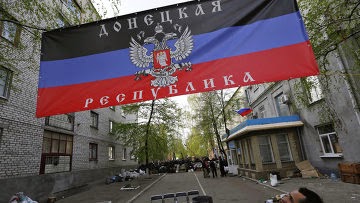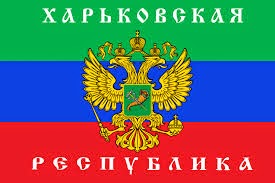International media coverage of the ongoing civil war in eastern Ukraine since the Ukrainian national elections on May 25th has been intensive and unrelenting—as it should be, for this important story. But not every news source seems to have noticed that the self-declared “people’s republics” of Donetsk and Lugansk, in the ethnic-Russian stronghold along the border with Russia, have ratcheted up their claims to stake out a separate territory in Ukraine that is friendly to Moscow, not Kyiv or Brussels or Washington. I present to you the Federal State of Novorossiya (Федеративное государство Новороссия)—Novorossiya being the Russian for “New Russia,” as the area that is today southern Ukraine was known in Czarist times.
 |
| Pavel Gubarev (center), during the first “Donetsk Republic” putsch, in March |
On May 13th, with the Donetsk People’s Republic (D.P.R.) already regarding itself as independent (though unrecognized, even by Moscow), Gubarev announced, “I, on my behalf, hereby proclaim the creation of a new political party, Novorossiya, whose head office will be in Donetsk. The new party will be led only by those people who in this difficult time showed themselves as true patriots of their Motherland and proved themselves as true fighters and defenders of their Fatherland.”
 |
| Denis Pushilin formally announcing the creation of the Federal State of Novorossiya |
 |
| Novorossiya delegates voting on May 24th in Donetsk |
 |
This map (which is open to debate) purports to show areas of total (red)
and partial (pink) separatist control in Donetsk and Luhansk oblasts as of May 24th.
|
 |
| The triumphant Vostok Batallion today in the Donetsk Republic headquarters (New York Times photo) |
Russia’s president, Vladimir Putin, has used the imperialist term Novorossiya as well, mentioning in a speech that it was only a quirk of history that made the region, dominated by Russian-speakers, part of an independent Ukraine in the first place. And as early as January of this year, this blog was reporting on ethnic-Russian nationalists in Crimea—which at that point had not yet seceded from Ukraine—calling for a similar territory to be called Malorossiya, or “Little Russia.” That Czarist name more properly refers to the borderlands of the Donbass and north, including Kharkiv, rather than the plains just north of Crimea. But a map circulated at the time showed Malorossiya swallowing up much more than the less-than-half of Ukrainian territory claimed by today’s Novorossiya separatists (see map below).
What is not clear is what form this new entity of Novorossiya will take. Is it to be a loose federation, along the lines of the “Union State” that today links Russia and Belarus—or something closer to full independence, or closer to Russian Federation membership? That has not been clarified. Though perhaps, for a clue, we can look to a scrawled-upon map in the office of the chairman of the D.P.R.’s Supreme Soviet (yes, sadly, it is called that), Denis Pushilin, an image which has been widely circulated on the Internet. It shows both Crimea and a large chunk of southeastern Ukraine (more like the above Malorossiya map than the current Novorossiya one) labeled simply, “Russia”:
However, Novorossiya does have a flag—or two, or three. Earlier this year, Gubarev, on his Facebook page, solicited flag proposals from the public, resulting in an informal contest (see the web page http://novorossia.su/flag, which includes, disconcertingly, the almost-defunct “.su” domain suffix for the Soviet Union). Here were the eleven finalists:

The last, no. 11, has circulated fairly widely on the Internet, including as the masthead image of a pro-Kremlin Facebook account with the risibly definite-article-free title “Truth about Situation in Ukraine”:
This proposal (above) is simply the Russian tricolor with a cross superimposed on it. Chillingly, the cross in question is the Ehrenkreuz (“Honor Cross”) used by Nazi Germany. Other submissions, in particular the tricolors, echo the flags of the already-declared “people’s republics” in the region (from left to right, Donetsk, Lugansk, Kharkov, and Odessa):
This is especially true of another Novorossiya flag which has been seen around lately, which seems to be a modification of the Russian tricolor with Ukraine’s blue and yellow and, like the “people’s republic” flags, features a double-headed eagle from the Russian Empire’s (and post-Soviet Russia’s) coat-of-arms:
A flag enthusiast and blogger named “Arcktick,” who opposes Ukraine’s disintegration, offers a deconstruction of this submission which is almost dizzyingly talmudic. It involves taking the average of the most common colors in Ukrainian oblast flags and finding the most felicitous arrangement. Interestingly, it resembles most closely a former flag of the Kingdom of the Netherlands—
—(with orange of course corresponding to Protestantism and the House of Orange), which is ironic given one version of the origin of the Russian tricolor, which is that it modeled itself on the flag of the Netherlands, that being the nationality of an engineer aboard the first Russian naval vessel, in the 17th century. The modern Dutch national flag is the same as Russia’s current one, with the stripes rearranged:
To no one’s surprise, the winning entry in the contest uses the Russian colors of red, white, and blue, which are also the colors, for example, of the post-Soviet (and also post-annexation) flag of Crimea—
—which merely transposes the top two stripes and expands the now-centered white one. The first inkling of what this Novorossiya flag would look like was on Gubarev’s Facebook page in December 2013, though without a caption:
A photo of an apparent official unveiling of this flag (with slightly different tints) appeared in the online magazine Ukrainian Policy, though I have not been able to confirm the source of the photo:
 |
| The Novorossiya flag (with the Donetsk People’s Militia emblem below it) |
As American readers may have noted, this is nearly identical to the frequently seen battle flag of the Confederate States of America from the period of the American Civil War (not the C.S.A.’s national “Stars and Bars” flag, incidentally—which is less commonly seen today—
—but the flag most commonly used today used to invoke Confederate heritage or sympathies—
—which is actually a variation on several C.S.A. member states’ battle flags). The only difference, other than variations in proportions and shading, is the presence of stars in the Confederate version, which are lacking in the Novorossiya flag. Could the Ukrainian separatists be invoking the rebelliousness, the David-and-Goliath courage, or the sheer anti–United States sentiment of the original Confederacy? Indeed, the geographical contours of these two southerly separatist movements are surprisingly similar:
(A further parallel—depending on how far one wants to take this—is that the original Southern U.S. secessionist movement, along with its modern, fringe-politics remnant, emphasizes the supposedly more “English” and “Celtic” nature of Southern white culture, as opposed to the (immigrant-“contaminated”) “Yankee” culture. The modern, white-supremacist League of the South (L.S.), which uses the Confederate battle flag (above) as its “national” flag, even uses British spellings such as colour and organisation, thus rejecting the American spelling reforms of the Connecticut-born Yankee traitor Noah Webster. Like the Russian ultranationalists in eastern Ukraine, the L.S. rejects the central government (in Kyiv, rather than Washington) in light of perceived cultural and historical commonalities with the “mother country.” The fact that the Confederate “Stars and Bars” and battle flags more closely resemble the Union Jack (see below for more discussion of the Union Jack) than they do the U.S. “Stars and Stripes” is a further reflection of this.)
 |
| Some Southern nationalists in the U.S. use a black-and-white version of the St. Andrew’s Cross, (more on that below) with visual resonance of the flags of both Scotland and Alabama. |
This uses the St. Andrew’s cross (saltire)—which is also the flag of Scotland—and St. George’s Cross—also the flag of England—which are also ingredients of the United Kingdom’s national flag, the Union Jack:
SS. George and Andrew were both prominent patron saints in the Russian Empire, as they have long been in the British Empire. In fact, the St. George’s Cross shows up in the flag of the formerly-Soviet Republic of Georgia (the patron saint of Georgia being, naturally, George)—
(incidentally, those are Jerusalem crosses, not Nazi Ehrenkreuzen!)—and the flag of the Black Sea Fleet, which Russia captured, in violation of an earlier treaty, when it annexed Crimea, is merely that of Scotland with the colors reversed (see below, on the right, amid the Russian flags):
(In fact, in the contest entries shown above, St. Andrew’s–type saltires are almost as common as Czarist coats-of-arms.) And of course the history of naval power in the Czarist empire has been an important historical, geopolitical, and symbolic rallying point in southeastern Ukraine’s pro-Russian rebellion.
 |
| The D.P.R. foreign minister, Yekaterina Gubareva, in front of Slovyansk municipal flags, wears the Soviet-era “St. George’s Ribbon,” which has become a symbol of pro-Russian separatism in Ukraine. |
[You can read more about Novorossiya and many other separatist and new-nation movements, both famous and obscure, in my new book, a sort of encyclopedic atlas just published by Litwin Books under the title Let’s Split! A Complete Guide to Separatist Movements and Aspirant Nations, from Abkhazia to Zanzibar. The book, which contains 46 maps and 554 flags (or, more accurately, 554 flag images), is available for order now on Amazon. Meanwhile, please “like” the book (even if you haven’t read it yet) on Facebook and see this interview for more information on the book.]
Thanks are due to Stanislav Zamyatin and Szymon Pawlas, of the Facebook group “Flags of the World,” for alerting me to some of the vexillological information.













































































